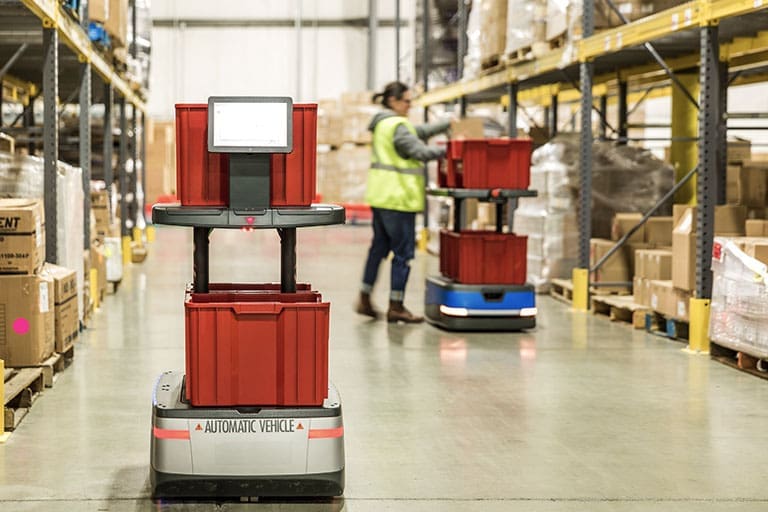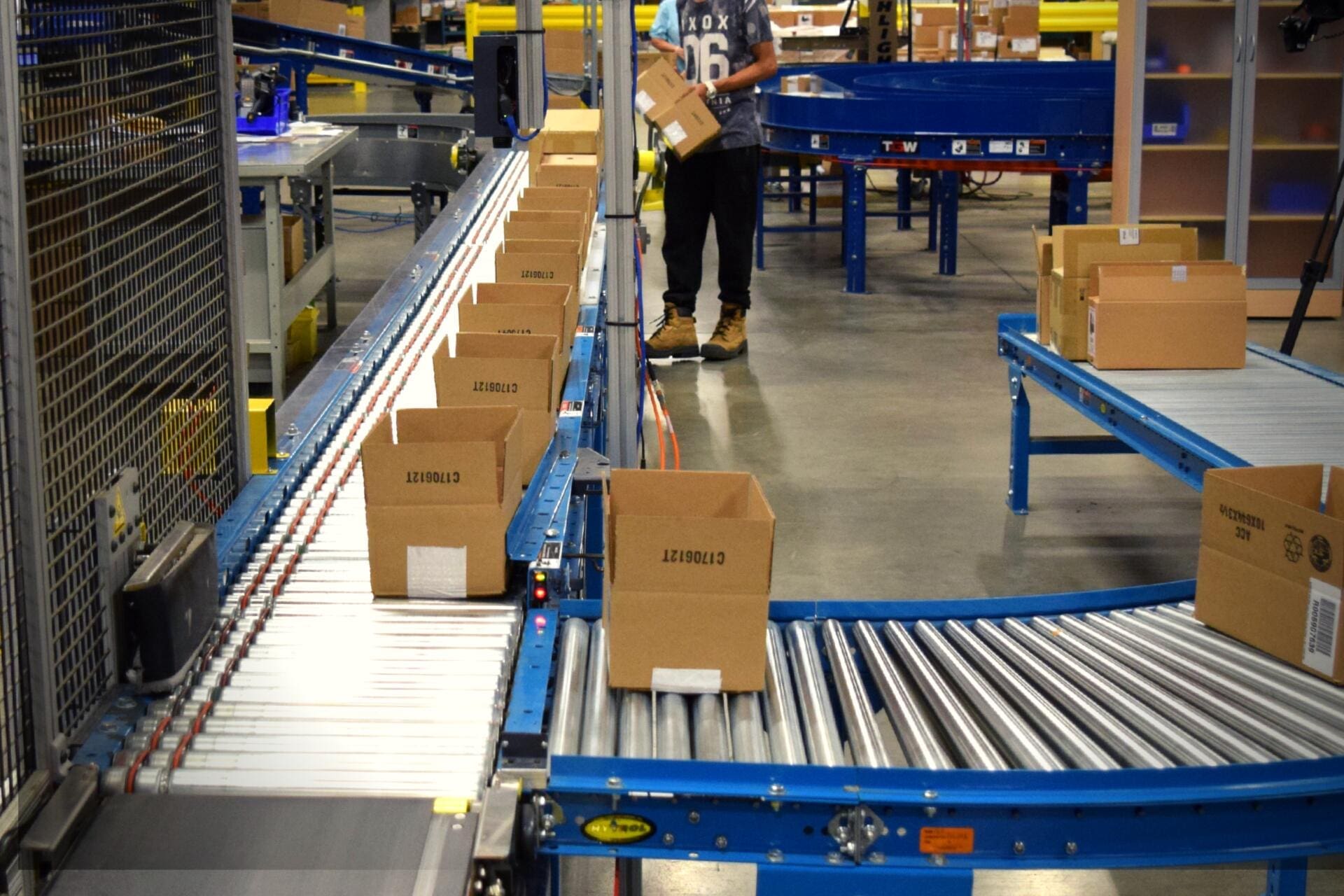Ever wonder how the crucial business of moving goods in a digital economy is evolving to keep up with ever-increasing customer expectations? This article will provide some good answers, with an overview of what goods-to-person automation is, how it compares to Person-to-Goods, and why many believe it’s the future of efficient operations.
Today, most distribution centers rely on a person-to-goods picking model, which entails that warehouse workers physically work their way through a maze of shelves and storage containers to collect the required items for a customer’s order. Converging trends are pushing this model to the breaking point.
There’s an explosion in the number of stock keeping units (SKUs), a less predictable workforce consistency and availability, and the pressure to deliver to the customer faster. To top it off, the rise of e-commerce is producing its own impact on this industry, influencing productivity requirements and storage capacity, forcing companies to seek faster, more efficient systems to transform the traditional, slow, and labour-intensive model. Many companies are now turning to Third Party Logistics (3PL) for goods-to-person automation to help them keep up with changing consumer demands.
Person-to-Goods versus Goods-to-Person Automation
The goods-to-person automation model entails reversing the traditional process. Instead of workers navigating rows of shelves and containers for the inventory they need, the inventory is brought to them.

The process is simple. Goods arriving in the entreposer are sorted, by an automated process or by hand, and placed into totes for smaller items or trays for larger ones. These containers are then stored in high-density, automated retrieval systems, using carousels or robotic systems. When an item is needed for an order, the picker simply requests it via a terminal and the container holding the SKU requested is automatically retrieved and delivered to the picker at a centralized pickup station or to a palletizing station. Automation comes in various configurations: put wall (hybrid version of goods to person tech), carousels, conveyors, or robotics.
Put Wall
The put wall is not a true goods to person solution but somewhat of a hybrid solution for those looking to cut costs on initial investment. This automation comes in many different forms of automation but the basic idea is to have one warehouse worker load the units into the put wall on one side organized into different SKUs or orders. As orders come in a warehouse worker on the opposite end of the wall will pack the order. Sometimes more complex versions of this solution allow for automated packing based on orders.
Vertical Carousels
The vertical carousel has been increasingly a more common solution as it maximizes space in the warehouse. It works by using a series of trays attached to a rotating chain which loops around both backwards and forwards similar to a ‘Ferris Wheel’. Although each system has different add-ons, the concept of each unit remains the same, the vertical carousel can deliver items to a surface at the click of a button.
Horizontal Carousels
Horizontal Carousels have an advantage as they can store and deliver larger heavier items than the vertical carousel. They are usually more than one unit installed so that they can be consistently putting out items. They work similar to the vertical carousel however instead of rotating towards the ceiling, they rotate horizontally through the length of the unit.
Vertical Lift Modules (VLMs)
VLM technology is the most flexible as it can automatically adjust to inventory changes. The unit is built to handle everything from large to small units. The countertop where units show up are ergonomically designed at waist height for maximum productivity. Because you can custom design each tray, it’s very easy to maximize the space utilized by each item of inventory.
Robots / Cobots
Robot solutions for the most part come in 2 different standard formats, floor robots and robotic shuttles. Floor robots, also known as collaborative robots, or “cobots” were invented with the idea of portable storage units delivering items to the picker. Once the item is picked from the robots storage, that robot will return to its original location to maximize space and speed. Robotic shuttles differ in the sense that they are built on rails, these robots are able to retrieve cases, totes or trays from the shelving along the built in rails. Both solutions are scalable as they allow for increased productivity with minimal structural investment as it is only required to increase the number of robots in order to increase production.

Sounds like science fiction? Not quite! It’s only natural that logistic operations should evolve, just like the rest of the business cycle, in a word that is increasingly intelligent and automated. The real question at this point is whether your business is ready for Goods-to-Person, the future of warehousing, and how it stands to benefit from it.
Goods-to-Person Automation Helps the Warehouse Worker
Automation technology is an enabler for all involved, including the warehouse worker. With automation, companies are providing their workforce with the means to get more volume/productivity out of their current workforce. Automation helps alleviate turnover and the personnel shortage, both notorious challenges in the warehousing industry. Training in an automated facility can take only two to three hours compared to two weeks in the previous model. Workers notice the hardships of the job are reduced, as they now are able to complete their tasks in a station instead of spending their day walking around a warehouse.
Goods-to-Person Automation Is an Affordable Solution for Streamlined Operations
The overall transformation to a digital economy makes for an increasingly complex warehouse environment. Businesses are feeling the pressure to streamline operations and cut down on cost. Once all things are considered, automating fulfillment often turns out to be the most cost-efficient option. And that’s before factoring in all its benefits.
Implementing the latest technology in goods-to-person systems makes good business sense because it impacts the bottom line on many levels.
Higher Accuracy
Errors are costly, and automation helps to avoid them. In our industry, it is estimated that the cost per error ranges from $50 to $300. Multiplying the error cost by a 1%-3% error rate, it’s easy to realize that manual handling of goods has a real impact on your company’s bottom line—especially when you consider slimming profit margins.
Increased Speed
Speed correlates with improved productivity. Automated systems find inventory items almost instantaneously, virtually eliminating search time, and by choosing the best, fastest routes, they speed up and streamline the item retrieval. Most importantly, by leveraging robots and conveyors, automation significantly accelerates order fulfillment, which in turns leads to faster customer delivery.
Improved Customer Satisfaction and Loyalty
Customer is king, they say, and happy customers are good for business. Expectations are higher than ever, and automation delivers better experiences. Customer satisfaction and loyalty, in turn, drive growth through repeat business and referrals.
 Maximized Warehouse Space
Maximized Warehouse Space
Automation maximizes warehouse space by using robots and other automated vehicles for retrieval and reducing the need for wide aisles to accommodate large pallets, pallet jacks and workers.
Better Inventory Counts
By decreasing human error, automation streamlines gestion des stocks and expedites more accurate inventory counts.
Enhanced Workplace Safety
With inventory coming to the workers (rather than the other way around), foot and equipment traffic is decreased, enhancing overall warehouse safety and the worker’s overall experience.
What are the Challenges of Goods-to-Person Automation?
For all its benefits, automating warehouse operations does come with some challenges:
- A low or fluctuating fulfillment volume can constitute a good reason to rule out an automation initiative. The threshold for automation to be considered is around 5,000 orders a day.
- The disruption of “normal” operations, which may add temporarily to the complexity automation is supposed to solve.
- The need to advocate for and manage change—when the perception may be that the current system was perfectly efficient.
- The necessity to retrain staff and develop a new culture centred on adding value to the customer rather than just moving goods.
- Just like any other technological equipment, Goods-to-person automation will require regular maintenance and occasional repairs.
- The upfront investment of implementing a new system until the ROI kicks in.
Striking the Right Balance for Your Business
Like any other business decision, implementing automation initiatives in the warehouse requires as a first step, a careful analysis of the business’s unique context and needs. Automation is not a one-size-fits-all solution. One of the strengths of automation is that it is actually highly customizable to specific characteristics of a business’s environment. The goods-to-person model often offers the most viable route, because it is a flexible, adaptable solution that allows users to meet a wide variety of space configurations, products and customer needs, not to mention the need to future-proof warehouse operations.
The Automated Warehouse Is More Than a Trend
One thing is certain, automation is part of the warehousing industry’s future. Early adopters will use automation as a competitive advantage. With the help of new technologies, they will transform the traditional warehouse, switching to smaller, more efficient storage spaces. Automation will help reshape the value proposition to workers, offering comfortable work conditions and a more rewarding experience, helping with crucial staff retention. The cost-effectiveness of automation will only become more apparent and tangible, as manufacturers of new automation make their technology cheaper. Automation in one form or other is bound to become the norm, to better answer customer needs and expectations for more speed, more customization, and more fulfillment choices.
The journey to goods-to-person automation is one that needs careful planning. We at SCI are making it our mission to help make businesses better through the adoption of technology logistics that reduce complexity and achieve operational efficiencies, saving you time and money. Your business is unique, and we’re there to help you select the best solution to see you on your way to the next step of your digital transformation.
Contact an SCI sales representative to learn more about automation, or to book a tour of our facility and get a closer look at how SCI utilizes automation in our operations.
 Maximized Warehouse Space
Maximized Warehouse Space